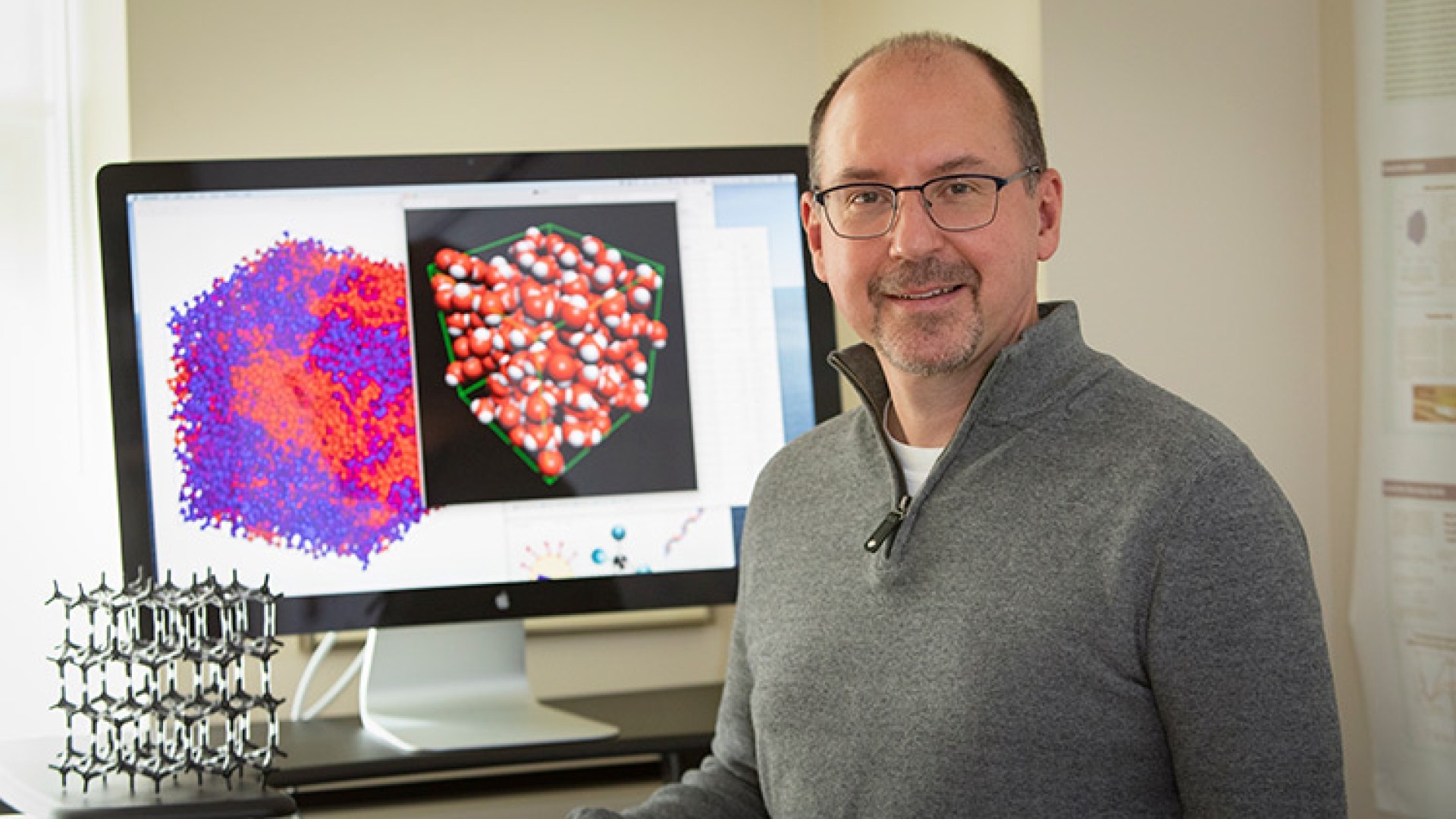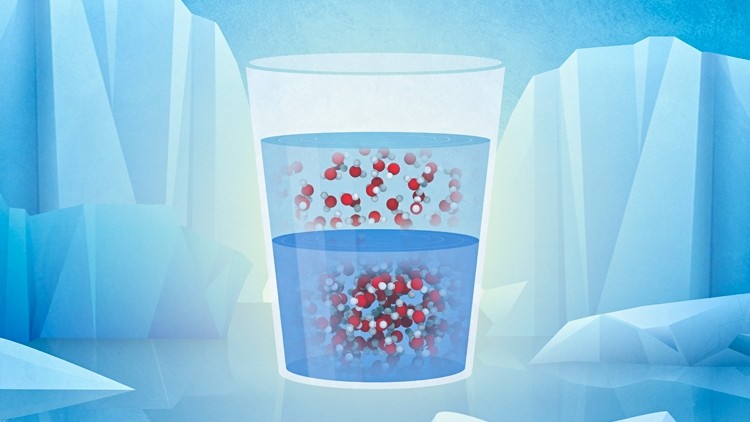
Unsolved questions about the way water behaves and why it is so different from other liquids is a problem that has puzzled scientists for many years.
But now, StFX physics professor Dr. Peter Poole is part of an international collaboration of scientists who’ve taken a big step forward in understanding how water behaves. The team has published a paper in the prestigious journal Science, presenting work believed to be the most convincing experimental demonstration to date of a liquid-liquid phase transition in supercooled water.
It’s a problem Dr. Poole has been involved in working on since he was a graduate student in Boston in the 1990s.
In the paper, "Experimental observation of the liquid-liquid transition in bulk supercooled water under pressure," they present the results of the first experiment in which supercooled water is ‘caught in the act’ of switching from high-density liquid (HDL) to low-density liquid (LDL), a problem that has evaded scientists for years.
Dr. Poole says achieving this result required assembling an international team of 21 scientists from Sweden, Korea, the U.S., Germany and Canada. The experimental team was led by Anders Nilsson at Stockholm University. Samples of frozen ultra-pure water were prepared in a custom-designed sample holder in Sweden and then shipped in a cryogenic container to South Korea. There, one of the most powerful x-ray lasers in the world was used to achieve what was previously impossible.
“Using intense laser pulses lasting less than 50 femtoseconds (a femtosecond is one millionth of one billionth of a second), precise snapshots of the liquid molecular structure were obtained well before ice formation could occur. For the first time, this allowed us to follow the phase transition from HDL to LDL in detail as it happened,” says Dr. Poole.
Although mainly an experimental paper, Dr. Poole says he and U.S. colleague Nicolas Giovambattista contributed by conducting computer simulations to shore up the experimental results and help with interpreting the data. All the simulation work was done using ACENET and Compute Canada resources.
SIGNIFICANT IMPACT

“The results presented in this Science paper open up a great many new directions for future research,” he says.
“Water plays a fundamental role in a vast range of science, technology, and industry. The existence of the LDL/HDL phase transition in supercooled water has profound implications for how we understand many important processes.”
As an example, supercooled water plays a central role in cloud formation and rain, which is a major influence on earth’s climate. Understanding the molecular structure of water, and how it can change, is central to many aspects of cell biology. Clarifying the behavior of water under low temperature conditions is also key for understanding our solar system, where water occurs in great quantities in comets and the outer planets.
The new techniques developed to conduct this experiment also have great potential for future discoveries, he says.
“This work illustrates how experiments can now probe complex processes occurring in matter on extremely short time scales, which previously could only be studied using simulations. Now that the time scales probed by experiments and simulations overlap, results from both can be directly compared, greatly improving our ability to use these approaches in concert.”
COMMON, IMPORTANT, AND WEIRD
“Water is both common and important. And yet, it is also weird,” Dr. Poole says.
“Compared to other common liquids, such as oil and alcohol, water has a lot of strange properties. Ice floats on water. Most other solids sink in their melts. Below 4 C, water expands when cooled. Most liquids contract when they get colder. Water becomes more fluid when under pressure. Most liquids become more viscous under pressure.”
All this weirdness gets even weirder, he says, when water is supercooled—water below the freezing temperature.
“Under these conditions, water will eventually turn into ice, but until this happens, you can still measure the properties of the liquid. The strange properties described above become even more dramatic in supercooled water. The colder water gets, the weirder it gets. But then something frustrating happens.
“Just when things are getting really interesting in supercooled water, ice formation starts happening so fast that normal experiments can’t measure the properties of liquid water anymore. There just isn’t enough time to measure anything before the sample turns into ice.”
In 1992, as a graduate student, he was part of a team at Boston University using computer simulations to study this problem. Using computer simulations, they were able to measure the properties of deeply supercooled water faster than in any experiments at the time. They found something very unusual.
“We found that if the temperature is low enough, there are two kinds of liquid water, a low-density liquid (LDL) and a high-density liquid (HDL). The change from LDL to HDL at low temperature is a sudden and dramatic ‘phase transition.’ We showed that the existence of this phase transition provided a simple and unified way to explain all of the unusual properties of water,” he says.
Since 1992, many experiments have attempted to test their theory and find evidence for the LDL/HDL phase transition. Some have found tantalizing evidence suggesting that the phase transition exists, but rapid ice formation continues to get in the way of a definitive ‘smoking gun’ result.
EXCITING COLLABORATION
“It was exciting for me to get involved with this kind of massive experimental effort. I am not an experimental physicist by trade. Most of my work involves creating theoretical or computer models, and I became involved in this collaboration in order to perform computer simulations of the exact process that was occurring in the water samples in the experiment. Working with my colleague, Nicolas Giovambattista at the City University of New York, we recreated the experimental conditions in our water simulations, and showed that the data coming out of the experiments was completely consistent with the predicted phase transition.
“Our simulations also helped to clarify how water reacts to the ultra-rapid changes in temperature and pressure explored in the experiments.”
Dr. Poole says all of the computer simulations for this work were carried out in Canada, using the resources of ACENET and Compute Canada.
“The first-rate scientific computing facilities available to us in Canada were crucial for making it possible for us to be part of this international effort, and provided us with the considerable computing horsepower required to contribute to making the entire project a success.”
Dr. Poole says the impact of this study is important because the substance they’re studying is so important. “No substance on the planet is more important than water,” he says. “Everybody depends on water.” So to have discovered and demonstrated how the structure of water at the molecular level could be changing in different environments allows one to rethink a lot of ways that water behaves and the role of water in many different processes.
“It’s fascinating to me to think about this trick Mother Nature has played on us,” he says. “Water pervades our everyday life, yet it’s still full of mystery.”
Just published, the paper has already attracted news attention, including the following articles:
* https://physicstoday.scitation.org/do/10.1063/PT.6.1.20201119a/full/
* https://www.sciencenews.org/article/supercooled-water-phase-critical-point-liquid-fluid
This research is, in part, made possible by the Government of Canada Research Support Fund.

